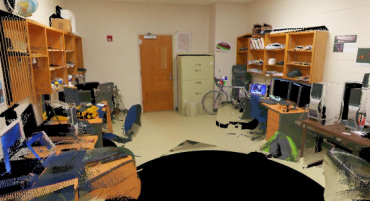I had written previously about the better image quality when using the Nodal Ninja setup, compared with the images of the built in web cam on the Leica C10. Below is a comparison, but before you examine the images let me make a few statements.
1) The imagery from the web cam in this instance I consider to be very good.
2) I took the scan images and the Nodal Ninja images on two separate days, so some stuff (chairs, bikes, book bags, etc...) changed position. This results in the images and point cloud not matching up perfectly for the nodal ninja example.
3) The resolution of the scan was 1cm at 10m 360x270.
1) The imagery from the web cam in this instance I consider to be very good.
2) I took the scan images and the Nodal Ninja images on two separate days, so some stuff (chairs, bikes, book bags, etc...) changed position. This results in the images and point cloud not matching up perfectly for the nodal ninja example.
3) The resolution of the scan was 1cm at 10m 360x270.
Obviously, in comparison the Nodal Ninja images are of higher quality, and taken outdoors or in very low lighting, this would become even more apparent. However, the Nodal Ninja does have some disadvantages, significant disadvantages. While it does allow for faster image acquisition in the field, post processing the images is time consuming. Additionally, you have to pick common points to match up the images and the point cloud, which can result in a misaligned image on the point cloud. Of course, the scanner images are always perfectly aligned and require less post processing, so it really depends on how important high quality imagery is for viewing vs. having high quality imagery for measurement or point cloud filtering. For the later, there are better options aside from what Leica Geosystems offers, such as the Riegl VZ400/Nikon D700 which contains an integrated full frame D-SLR allowing for technically accurate pixel-point matching.
In summary, we only use the nodal ninja setup for 360 degree panoramas and Quick Time Virtual Reality (QTVR) images. Using the images with the scan data is far to tedious and error prone to be used in any meaningful way.
In summary, we only use the nodal ninja setup for 360 degree panoramas and Quick Time Virtual Reality (QTVR) images. Using the images with the scan data is far to tedious and error prone to be used in any meaningful way.



